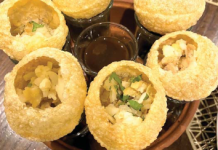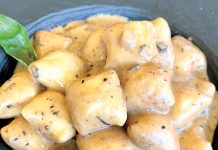by Andy McDonough
Since the days of the first North American settlers at Plimoth plantation, we Americans have had a love affair with the turkey. Turkeys might not be the prettiest birds, but they sure taste good. According to the U.S. Department of Agriculture, more than 45 million turkeys are cooked and eaten at Thanksgiving and that’s about one-sixth of all turkeys sold each year. A huge percentage (almost all) of the turkeys we consume are a breed called Broad Breasted White. You shouldn’t be surprised if you don’t know that. When I asked my neighborhood butcher, who has been taking orders for farm-raised turkeys for close to 30 years, he said, “There’s breeds?”
Equipped with sadly short legs, a huge breast and a remarkable ability to survive in overcrowded and disease-ridden conditions, the Broad Breasted White was chosen by the food industry to be raised factory-style to meet Americans’ overwhelming taste for white meat. The birds are slaughtered, sanitized and injected with flavoring and oils—you’ll see why in a minute. Then, they are packaged and frozen into convenient blocks that can be stored for up to a year or more. Convenient? Yes. Practical? Certainly. Turkey at its best? Maybe not.
For as long as we’ve been gobbling up those big birds, there have been rumblings that the frozen blocks we thaw and prepare at the holidays are more frequently dry, tasteless, and bear little or no resemblance to the succulent, tasty birds enjoyed by our forefathers (or even our grandparents). In addition to complaints from the culinary peanut gallery, many naturalists feel that the popular methods for ‘growing’ such a quantity of commercial poultry, including the accepted practices of using pesticides and hormones, are inhumane and, in many cases, unsafe.

Because of this, and because naturally grown birds taste better, in 2002 the American Livestock Breeds Conservancy, a non-profit dedicated to protecting breeds of farm animals from extinction, and Slow Food, a global organization dedicated to preserving artisanal foods and production practices, joined forces to work with farmers to try to save four of the best-known heritage turkey breeds before they became extinct. They are:
The Bourbon Red – Also known as the Bourbon Butternut or Kentucky Red, was named for Bourbon County, Kentucky, in the bluegrass region, where it originated. It was developed from stocks of the Jersey Buff, taken to Kentucky and selected for improved meat production and a darker red color.
The Jersey Buff – An historic variety from the mid-Atlantic states, named for the beautiful color of its feathers and used in the development of the Bourbon Red variety early this century.
The Narragansett – A breed hailing from Narragansett Bay, Rhode Island, it was the first American turkey breed from a cross between native Eastern Wild turkeys and the domestic turkey stock brought by English and European colonists.
The Standard Bronze – This breed is named for its unusual shimmering green-bronze color, which appears metallic in the sunlight. It was bred from Narragansett and wild turkeys, and was the most popular turkey for many years until the Broad Breasted White was crossbred to provide more white meat. The Standard Bronze also has a place in history as the breed depicted in the iconic Norman Rockwell painting, “Freedom From Want.” It’s also the bird Benjamin Franklin proposed as the national symbol of America.
You can find other Heritage turkeys, too, like Royal Palms and Grey Slates. There’s also the common ancestor for all heritage breeds, the wild turkey native to the Americas. There are a lot of breeds and words to describe the farming practices used to raise them. It can get confusing. Here are some important terms you see most often:

Heritage Turkey or A Legacy Bird – While there are no legal or set guidelines to define heritage animals, to be truly heritage the animal must have a specific set of genetic traits and be raised sustainably on pasture, where they can forage and carry out their natural behaviors. Sadly, while there are efforts under way to reintroduce them to the public, almost all heritage turkeys are near extinction. Organizations devoted to the preservation of artisanal foods, local farms and restaurants are helping promote and market the breeds in order to save them. Be aware that the term “heritage” is unregulated, and definitions of exactly what constitutes a heritage breed may vary.
Organic Turkey – An organic turkey can be any breed, including a Broad Breasted White. The term “organic” simply means that the bird has met the standards for USDA Organic certification, including an organic diet, surroundings including bedding and grazing areas that are pesticide and herbicide free, no hormones or antibiotics, and humane treatment. For many consumers, lack of pesticides and hormones in their food is the most important consideration, and why they purchase organic foods.
Antibiotic-Free Turkey – Similar to organic, these turkeys can be any breed. They have not met the more stringent standards for USDA Organic certification, but they have not received antibiotics.
Free-Range Turkey – These birds were not confined to a cage, but were allowed to roam and forage in a way that birds do naturally. This means that, unlike their confined counterparts, these birds’ diets are augmented with grubs, worms, and grass, which has the effect of improving the flavor and texture of their meat.
These descriptions of the birds give some important clues as to their quality and how they will taste. So what does create natural flavor in a bird? Essentially the same for any animal, it is a function of four factors: genetic stock, age, exercise, and food.
Genes – What we taste when we eat an animal, its flavor and nuance, is very much a fundamental expression of an animal’s genetic stock.
Age – Older animals acquire more fat, which provides more flavor; and heritage animals grow more slowly than commercial animals. Heritage turkeys are generally seven or eight months old, compared to commercial birds which are three or four months old.
Exercise – The more exercise an animal gets, the more its muscular flesh builds, the better its flavor. Animals allowed to roam in pastures and free-range poultry in yards get exercise; animals confined in pens and coops do not.
Food – Animals allowed to graze and forage will develop a deeper flavor than those fed a pure grain diet (different grains, of course, also produce different flavors). Free-range turkey will eat those grasses, grubs and insects to produce more flavor nuances.
So, why do some people say that Broad Breasted Whites don’t taste as good as Heritage breeds? Well, there are a few obvious reasons. Broad Breasted Whites have short legs, cannot fly and have difficulty mating naturally. Engineered for size, the buxom toms are so top heavy that they cannot mount the hens and, as a result, the birds must be bred via artificial insemination. They are usually raised in crowded indoor factories and fed a diet of grains, often with antibiotic supplements to keep bacteria in check. It is not uncommon for these turkeys to be injected with saline solution and vegetable oils before delivery to try to improve the taste and texture of the meat.
In contrast, Heritage turkeys have less white breast meat and longer legs with more thigh meat. Typically, the Heritage turkey is richer as a result of the breed, feed quality and length of life. As mentioned above, heritage turkeys are older, slaughtered at eight months instead of the usual four to five months for a typical Broad Breasted White. This means Heritage birds have time to put on a bit more fat, leading to more succulence and a deeper, more complex flavor. In theory, this is why the organic and Heritage birds taste better and are more moist. It’s also the reason why commercially grown birds need to be injected with oil so as not to taste dry and uninteresting. Most Heritage breeds are raised free range, so they can roam in a yard, and forage for natural food that provide more flavor to their flesh. Their daily exercise gives them firmer flesh than birds who live their lives in cages. In addition, Heritage birds are naturally more active and can take flight. They even like to roost in trees, while Broad Breasted Whites can barely get off the ground.
Cooking Tips For A Perfect Bird
Something all turkey breeds have in common is that, regardless of the breeding and lineage, the final result lies in the skill of the cook. Even the very finest bird, when overcooked, will not be tender, juicy, succulent or moist.
Here are some tips to help you make the perfect turkey:
Brine the bird. Because Heritage birds are leaner, some producers recommend that you brine them for at least a day before roasting to enhance their juiciness.
Make it fresh. Heritage birds are sold fresh, not frozen, and must be prepared in 3-5 days.
Defrost it safely. If you have a frozen bird, it should be defrosted overnight in the refrigerator—not at room temperature, which encourages bacteria growth.
Birds should be cooked at 325°F. USDA-recommended temperatures for doneness are: breast meat 170°F, thigh meat 180°F, center of stuffing 165°F.
Cover up. White meat cooks faster than dark meat. About 2/3 of the way through the cooking cycle, you’ll need to cover the breast lightly with foil so it doesn’t dry out while the dark meat finishes cooking.
Use a meat thermometer. Instant-read thermometers are are fast and leave a smaller puncture. Insert it into the thigh close to the body of the bird. Be sure it rests in meat and is not touching bone. If you don’t have a thermometer, you can tell the poultry is done when the juices run clear, without any hint of pink. You don’t have to cut into the bird: tip it until the juices run from the cavity.
Remove your bird early. Meat continues to cook after removed from the oven, so remove it when it is 5 to 10 degrees below the final temperatures.
Let it rest. The often overlooked key to juicy poultry is to let it rest before carving. Cover the bird with foil to keep it warm and set it aside for 15 to 20 minutes (up to 30 minutes for large turkeys). Resting allows the juices to redistribute, making each bite more succulent.
Happy Thanksgiving!
Buying Guide to Free Range, Organic and Heritage Turkeys
Sickles Market, Little Silver offers the following fresh whole turkeys:
“text-align: center;”>Murray’s – family farmed and naturally raised in Pennsylvania, antibiotic-free, no additives, preservatives or flavor enhancers, 100 percent natural, juicy and tender. $3.69/pound.
New Jersey’s Griggstown Quail Farm offers two types of turkey for the Thanksgiving and Holiday seasons – both are 100 percent natural with no additives, antibiotics or hormones – The white turkey is a traditional breed that most individuals are used to, $4.69. By special order only – Griggstown’s Red Bourbon turkey – a heritage bird that has not been crossbred to enhance its size. The Red Bourbon takes longer to grow and is a smaller, leaner bird with darker meat, but there is still enough white meat to satisfy everyone. Despite its leaner disposition, the Red Bourbon turkey does not have a gamy taste, but does, in some inexplicable way, taste better. All turkeys are raised outside and are truly free range birds.
D’artagnan Certified Organic Free-range Turkey. Raised on a diet of nothing but 100% whole organic grains and pure spring water, with no protein supplements, added poultry or fish byproducts, pesticides or herbicides. Additionally no antibiotics, growth hormones or arsenicals are administered and the birds benefit from an environment that never uses artificial light. Adherence to these principles led to the first approval by the USDA for free range labeling, as well as to Organic Certification in 1990 by the Northeast Organic Farmer’s Association. $5.99 pound. Order by Nov. 14.
www.sicklesmarket.com (732) 741-9563
Whole Foods Market, Middletown, sells only antibiotic- and hormone-free turkeys. with no added solutions or injections. A variety of turkeys, including organics, Heritage and kosher, are available and can be pre-ordered.
www.wholefoodsmarket.com (732) 758-1688
Dearborn Market, Holmdel, sells DiPaola free range turkeys and Eberly organic free range birds.
www.dearbornmarket.com (732) 264-0256














